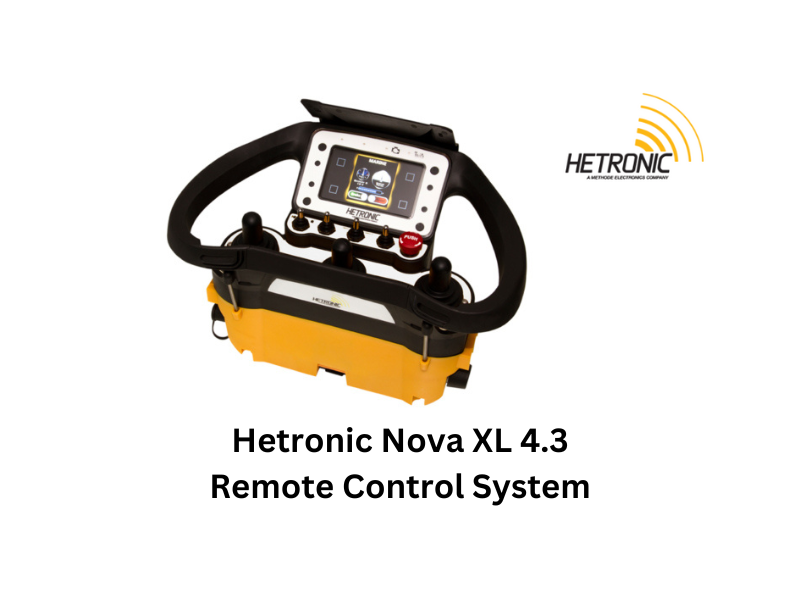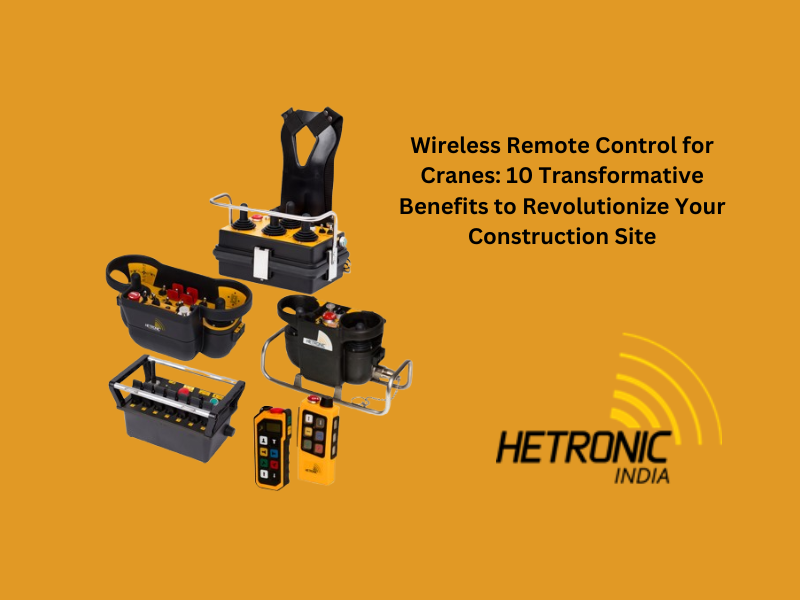Introduction: Understanding Wireless Crane Controls
In industries where the stakes are high and safety is paramount, the technology that powers heavy lifting operations must be as robust as the machinery itself. Enter wireless crane controls for hazardous environments—a leap forward in operational efficiency and safety that transforms how we approach material handling in challenging conditions.
Imagine a construction site enveloped in dust, or an oil rig beset by corrosive chemicals; traditional wired controls may falter under these extreme circumstances, but wireless crane controls systems thrive where others fail.
As businesses navigate the complexities of compliance and worker safety, understanding the intricacies of these advanced wireless solutions becomes crucial. From mitigating risks associated with entangled wires to enhancing maneuverability and precision, wireless crane controls are not just a convenience; they’re an essential component of modern industrial operations.
This article will delve into what you need to know about implementing these innovative control systems in hazardous environments—covering everything from their benefits to best practices for ensuring maximum reliability and safety on-site.
Whether you’re upgrading existing equipment or starting fresh, arming yourself with knowledge about wireless technologies can make all the difference when it comes to protecting both your workforce and your bottom line.
What Are Wireless Crane Controls?
Wireless crane controls represent a significant advancement in the efficiency and safety of material handling operations. By eliminating cumbersome cables, these systems grant operators greater mobility and freedom while maneuvering heavy loads.
With intuitive interfaces, modern wireless controllers often feature joysticks and buttons designed for ease of use, allowing operators to focus on precision rather than getting tangled in cords.
Moreover, the integration of advanced technology such as Bluetooth or Wi-Fi not only enhances operational range but also seamlessly connects with various lifting equipment.
This connectivity allows for real-time data monitoring, giving operators vital insights into load weight and environmental conditions that could influence safety.
Additionally, many systems are equipped with fail-safe protocols and emergency stop functions to ensure maximum safety on job sites—essentially allowing workers to control cranes from a safe distance while maintaining complete command over their movements.
In industries ranging from construction to shipbuilding, wireless crane controls not only boost productivity but also reduce downtime caused by equipment malfunctions or entanglements associated with traditional wired setups.
As businesses look towards greater automation and improved workplace dynamics, embracing this innovative technology will be pivotal for future-proofing operations against ever-evolving industry demands.
Importance of Hazardous Environment Adaptation
Hazardous Environment Adaptation is not just a necessity; it’s an imperative for survival and progress in our increasingly volatile world. As climate change accelerates and urbanization encroaches on wilderness, understanding how to adapt to hazardous environments informs everything from public policy to individual behavior.
By embracing adaptive strategies, communities can mitigate risks linked to natural disasters, economic upheavals, and even public health crises. This proactive approach fosters resilience—not merely in terms of infrastructure but also within societal frameworks and ecological systems.
Moreover, the integration of technology plays a pivotal role in Hazardous Environment Adaptation. Smart sensors and data analytics provide real-time insights into environmental changes, allowing societies to anticipate threats rather than react post-disaster.
For instance, cities utilizing predictive modeling can efficiently allocate resources during emergencies while enhancing local governance mechanisms that support vulnerable populations. This interplay between innovation and adaptability catalyzes sustainable development initiatives that ultimately safeguard future generations against unforeseen hazards.
As we confront the realities of our changing environment, fostering a culture of adaptability becomes critical. Educating individuals about personal preparation measures—such as emergency kits or community involvement—promotes a collective consciousness centered on readiness rather than fear.
In this way, Hazardous Environment Adaptation transcends mere survival tactics; it cultivates thriving ecosystems where resilience becomes second nature amidst adversity.
Key Features to Look For
When assessing any new technology or product, identifying the key features that align with your specific needs can significantly enhance your experience. Prioritize usability by looking for intuitive interfaces and customizable options that allow you to tailor settings to fit your workflows.
An essential feature is integration capability; ensure that the tool seamlessly connects with other applications you already use, reducing friction in your daily tasks.
Moreover, consider the scalability of the product. A solution that’s capable of evolving alongside your requirements will save you time and resources in the long run. For example, many software solutions now offer tiered subscription models that cater to both small startups and large enterprises.
Finally, don’t overlook customer support; robust documentation, active community forums, and responsive technical assistance can be vital resources when navigating challenges or unfamiliar features. These aspects not only enhance user experience but also foster a sense of security as you invest in long-term solutions.
Safety Standards and Compliance Regulations
Safety standards and compliance regulations play a vital role in fostering a culture of security across various industries. By setting benchmarks for operational practices, these guidelines not only protect employees and consumers but also enhance organizational reputation.
In an increasingly interconnected global economy, companies must navigate diverse regulations that can vary significantly by region or sector. This complexity makes staying informed about the latest updates essential for businesses aiming to maintain compliance while avoiding costly penalties.
One emerging trend is the integration of technology into safety protocols—an area ripe for innovation. Advanced data analytics can help organizations predict potential hazards before they materialize, shifting the focus from reactive measures to proactive prevention.
Additionally, collaborative platforms enable real-time sharing of compliance status across teams or with regulatory bodies, fostering transparency and trust. Ultimately, embracing this proactive mindset around safety standards not only minimizes risk but also enhances efficiency and productivity within the organization.
As we move forward, understanding safety standards will become paramount—not just as a regulatory obligation but as a strategic advantage in building resilient businesses equipped to thrive in an unpredictable world.
Selecting the Right Technology for Your Needs
When selecting the right technology for your needs, it’s crucial to begin with a clear understanding of your specific requirements and goals. This means going beyond mere specifications and delving into how the technology will integrate with existing systems, enhance productivity, and drive innovation.
Engage stakeholders from different areas of your organization to gather diverse insights; this collaborative approach can reveal unique challenges and opportunities that you might otherwise overlook.
One often underestimated aspect is considering scalability—choosing solutions that not only address current needs but also have the potential to evolve alongside your growth trajectory. Be wary of chasing trends; instead, focus on technologies that offer flexibility and longevity.
Additionally, think about user experience: A technology’s interface should empower users rather than complicate their tasks. By prioritizing both functionality and usability, you set the foundation for sustained engagement and maximize return on investment in technological assets.
Installation Considerations and Best Practices
When embarking on any installation project, whether it’s a complex software system or simple home appliances, understanding the environment is key. Assessing factors such as humidity, temperature fluctuations, and available space can save you time and resources in the long run.
For instance, electronic devices often have specific atmospheric requirements; ignoring these may lead to premature failure or performance issues. Therefore, taking meticulous measurements and conducting an environmental audit before installation should be a staple practice.
Adopting a robust plan that incorporates back-up strategies for unforeseen complications is also crucial. For example, having a rollback procedure in place during software installations can mitigate risks associated with new updates.
This could involve taking complete system backups to restore previous versions if necessary. Moreover, engaging team collaboration tools during installations promotes transparency; everyone stays informed of changes while potential problems can be addressed collectively before they escalate.
Ultimately, by prioritizing multi-faceted preparation and teamwork during the installation process, you not only enhance efficiency but also bolster the longevity and functionality of your installations.
Maintenance Tips for Reliable Performance
Regular maintenance is the cornerstone of reliable performance, whether for your vehicle or home appliances. One often overlooked aspect is the importance of sticking to a consistent schedule tailored to each item’s specific needs.
For instance, changing the oil in your car every 5,000 miles not only promotes better engine function but also extends its lifespan. Similarly, proactive cleaning and replacing filters in air conditioning units can dramatically enhance efficiency and air quality—boosting both comfort and energy savings.
Another vital maintenance tip revolves around using quality parts and materials during repairs or replacements. Many users opt for cheaper alternatives that may seem cost-effective initially, yet can lead to recurring issues down the line. Investing in high-quality components ensures that your system operates smoothly while reducing the frequency of future maintenance tasks.
Additionally, keep an eye on small details; something as simple as tightening loose screws on machinery or ensuring proper calibration on equipment can make significant improvements to overall functionality. By integrating these practices into your routine, you’re setting yourself up for long-term reliability and performance satisfaction.
Real-world Applications and Case Studies
Real-world applications of theoretical concepts often breathe life into abstract ideas, showcasing their practicality across various sectors. For instance, in healthcare, predictive analytics powered by machine learning is transforming patient care. Hospitals are leveraging algorithms to assess vast datasets and anticipate patient admissions.
This capability not only optimizes resource allocation but also enhances patient outcomes by enabling proactive intervention strategies. A notable case study involves a major hospital network that reduced readmission rates by 20% through such data-driven predictions.
In the realm of environmental sustainability, companies are increasingly turning to blockchain technology to enhance transparency in supply chains. A prominent example can be seen with certain food brands using blockchain to trace the journey of their products from farm to table.
By providing consumers with verifiable information about sourcing practices and environmental impact, these companies build trust while promoting ethical consumption behaviors. This application highlights a dual benefit: fostering corporate responsibility while empowering consumers with knowledge that informs their choices—and it’s just one instance of how emerging technologies can shape our interactions with the world around us.
Conclusion: Ensuring Safety with Wireless Controls
In conclusion, wireless crane controls designed for hazardous environments offer significant advantages in terms of safety, efficiency, and operational flexibility. Understanding the specific requirements and certifications necessary for these systems is crucial to ensure compliance with industry standards.
Additionally, selecting the right technology that suits your operational needs can greatly reduce risks associated with manual control methods. By implementing robust training programs for operators and maintenance personnel, organizations can further enhance workplace safety and reliability.
As you consider upgrading or implementing wireless crane controls, take proactive steps to evaluate your options and prioritize safety in your operations.





